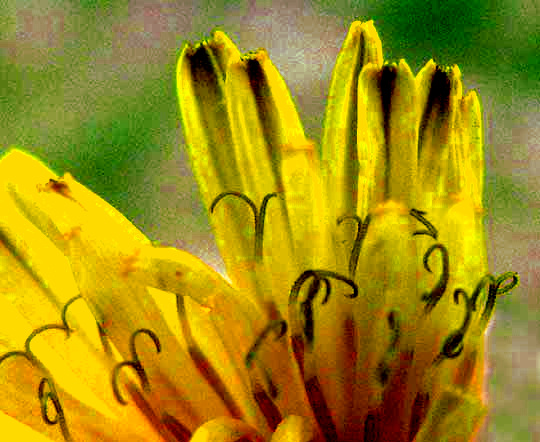Excerpts from Jim Conrad's
Naturalist Newsletter

from the the February 10, 2013 Newsletter issued from the valley of the Dry Frio River in northern Uvalde County, southwestern Texas, on the southern border of the Edwards Plateau; elevation ~1750m (~5750 ft); N29.62°, W99.86°; USA
DANDELIONS FLOWERING
My sense of spring approaching slowly and incrementally was disrupted this week by a rare trip to the nearest town, Uvalde, 35 miles (56km) to the south, for in Uvalde spring is much more in evidence than here at the cabin. The difference is caused less by the fact that Uvalde is farther south than that we're higher in elevation here. Uvalde stands at about 942 feet above sea level (287m) while here partway onto the Edwards Plateau we're at 1647 feet (502m). This difference of 705 feet doesn't seem much -- and when you're traveling north the rise in elevation is hardly discernible -- but it's enough for us to be assigned to a different USDA Plant Hardiness Zone from Uvalde; Uvalde resides in Hardiness Zone 8b while we're in 8a. This slight difference shows up in enormous differences in the natural vegetation. Here in the hills the most numerous tree species is the Ashe Juniper, while around Uvalde junipers are not to be see. Instead there are scrubby, spiny acacia-type trees. Street trees in Uvalde are putting on leaves and the grass is emerald green, while here our few deciduous trees remain leafless, and the grass still is mostly dun colored.
Though here it's been hard to find any flowering plants at all this week, in Uvalde's lawns and weedy lots it's easy to see flowers on the kinds of weedy, invasive plants that typically blossom in early spring across North America. For example, at my foot the moment I opened the door upon arriving in town there was the native Eurasian herb shown above.
Everybody knows that that's a Dandelion, TARAXACUM OFFICINALE. In the picture the Dandelion's leaves are the larger, arrow-shaped ones emerging from a mat of smaller bur-clover leaves.
Humanity is divided into those infected with the cultural notion that Dandelions are ugly and need to be uprooted from lawns, and those who are touched and pleased by the Dandelion's graceful, beautiful and generous presence in a lawn, and I'm in the latter group. For me, that day in Uvalde, seeing the flowering Dandelion so magically alive amidst all that tender spring greenness was simply a gift.
William Wordsworth wrote, "We murder to dissect," and there's something to that. However, as an Earthly animal with certain claims upon resources around me, such as the right to take what I need as nourishment, I've plucked the leaves of many Dandelions to eat. That day in Uvalde, needing a different kind of sustenance, I plucked the yellow flower head in the above picture, broke it open and looked, for somehow I needed to assure myself that the laws governing the geometry of flowers still were in force, and that they were as spiritually nourishing as ever. You can see the broken-open flower head below:

Dandelions are members of the Composite, or Sunflower, Family, so the Dandelion's yellow sunburst is a collection of flowers, a head, not a flower itself. In the above picture it looks as if many milk bottles are clustered near one another, and that some of the bottles are broken, with milk running here and there. There's white fuzz spewing from each bottle's mouth, and a long, yellow ribbon or strap-like affair tied to each mouth rim.
In that picture, each bottle is a future fruit produced by a single flower -- one fruit per flower. When speaking of the Composite Family such fruits technically are referred to as cypselae. The milk is white latex issuing from the plant's vessels broken by my dissection. The white fuzz atop each cypsela forms the pappus, which later will become the cypsela's white "parachute" when it launches into the spring wind. The yellow strap is the flower's corolla. If you follow some yellow straps upward you encounter features proving they are corollas, as shown below:

Notice that every corolla is tipped with five little teeth, or dentations. These are vestigial remnants of the five petals of flowers of simpler, more primitive ancestors. "Primitive," because members of the Composite Family occupy an outer branch of the evolutionary Tree of Life -- meaning that in terms of evolutionary history they arose fairly recently from less highly evolved ancestors. The first fossils of flowering plants, or angiosperms, have been found in rock strata about 135 million years old, but fossil pollen from Composites doesn't show up until around 25 million years ago.
In the above picture the Y-shaped items are branched styles with stigmatic surfaces along their inner faces. The stigmatic surfaces are where pollen grains germinate and send their male sex germs down in rootlike tubes through the styles to ovules in ovaries in the milk-bottle-like future fruits at the flowers' bases.
What a pleasure seeing that all is in order with this little flower. What a pleasure knowing that many more Dandelions will be appearing as spring blossoms all around us.